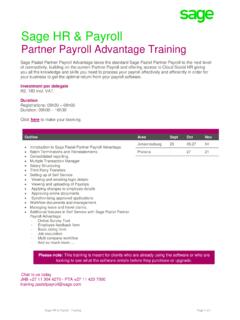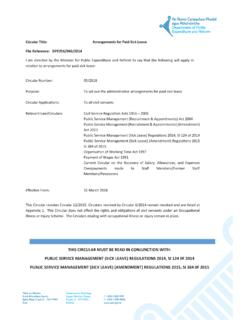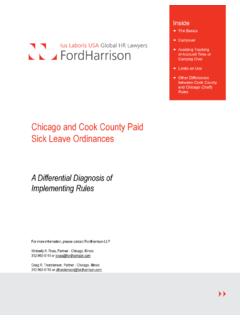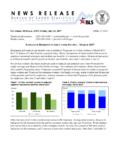Transcription of Tax and ETI Amendments 2017/2018 - Sage South Africa
1 Tax and ETI Amendments 2017 / 2018 Income Tax and ETI Amendments 2017 / 2018 Page 1 of 17 Contents 1 Employment Tax Incentive (ETI) Changes .. 2 Wage Qualifying Test .. 2 Before March 2017 .. 2 From March 2017 .. 3 Employed and Remunerated Hours .. 4 Actual Wage .. 5 Diagram to Illustrate the Wage Qualifying Test for Employees Without a Wage Regulating Measure .. 5 Wage Qualifying Test: Wage Regulating Measure vs. No Wage Regulating Measure .. 6 Remuneration .. 8 Before March 2017 .. 8 From March 2017 .. 8 Employed and Remunerated Hours .. 8 Diagram to Illustrate the Calculation of Remuneration for All Employees (With and Without a Wage Regulating Measure) .. 10 Calculation of the ETI Amount .. 11 Before March 2017 .. 11 From March 2017 .. 11 Roll-Over and Reimbursement.
2 12 2 Tax Changes .. 13 13 Payroll Changes .. 13 Remuneration Proxy .. 13 Employer Provided Bursaries .. 13 Directors Deemed Remuneration .. 14 RFI Definition .. 14 Reimbursive Travel Allowance .. 15 Certain Dividends Included in Remuneration .. 15 Value of B in the Residential Accommodation Fringe Benefit Calculation .. 16 Other Changes Not Affecting Payroll Directly .. 16 Partner of a Partnership .. 16 Disallowing the tax exemption for Local Fund Lump Sums and Annuities .. 16 Learnership Tax Incentive .. 16 3 References .. 17 Income Tax and ETI Amendments 2017 / 2018 Page 2 of 17 1 Employment Tax Incentive (ETI) Changes The Taxation Laws amendment Act, 2016, promulgated on 19 January 2017 in Government Gazette 40562, extends ETI for another 2 years, ending on 28 February 2019.
3 The Act contains the following changes to ETI. Wage Qualifying Test In order for an employee to qualify for ETI, he/she must pass the wage qualifying test which is one of the qualifying criteria to establish if an employee is a qualifying employee (other qualifying criteria includes; employed on or after 1 October 2013, 18 to 29 years old, valid RSA ID / Asylum Seeker Permit / Refugee ID Number, not a domestic worker, not a connected person to the employer and monthly remuneration must be less than R6 000). Wage refers to the cash amount paid for ordinary hours of work. This is typically basic salary or basic wage of the employee and excludes elements such as overtime, commission, bonus etc. and includes any leave pay (such as pay for annual leave, sick leave, family leave etc.). The wage the employee earns should be at least the minimum wage according to the wage regulating measure (collective agreement, bargaining council or sectoral determination) or R2 000 for a full month, which is at least 160 hours, if there is no wage regulating measure.
4 Before March 2017 If a wage regulating measure was applicable, then the monthly wage was compared to the minimum monthly wage (it was understood that a rate per hour comparison was allowed as this was effectively the same as grossing-up the wage). If no wage regulating measure was applicable the monthly wage was calculated in the following way: If the employee was employed for less than 160 hours per month, then a gross-up of the wage was performed to see how much the wage would have been for 160 hours. If the employee was employed for 160 hours or more, no gross-up of the wage was required. Hours employed referred to: Contractual normal hours (no overtime hours) in the case of a permanent employee for ETI purposes (those employees who work in terms of an employment contract that specifies a contractual predictability of regular work in the future.)
5 In other words, an employee with a standard amount of hours to work in a month). Actual total hours worked in the case of a temporary employee for ETI purposes (employee without a standard amount of hours to work in a month or an employee who works an irregular amount of hours, such as temps or casual workers). Actual normal hours employed for new and terminated employees. Please Note: The definitions for permanent and for temporary are not legal terms, but our own definitions we used to explain the legislation To simplify the calculation, from March 2015 the test was not based on the wage rate per month, but by applying a rate per hour comparison: The minimum wage rate per hour applied if there was a wage regulating measure, or If there was no wage regulating measure, an employee qualified if the wage rate per hour of the employee was equal to or more than (R2 000/160 hours).
6 Income Tax and ETI Amendments 2017 / 2018 Page 3 of 17 From March 2017 The legislation was amended to change the word from employed to employed and paid remuneration in order to clarify the applicable hours worked in the grossing up/grossing down calculation. The term employed has a different meaning to employed and paid remuneration and therefore some of the calculations are changing. Summary of the legislation for the wage qualifying test from March 2017 : If a wage regulating measure is applicable: The wage paid should be compared to the minimum wage of the wage regulating measure in respect of that month, it is understood that a rate per hour comparison is allowed as this is effectively the same as grossing-up the wage. If no wage regulating measure is applicable: If an employee is employed and paid remuneration for less than 160 hours in a month, then gross-up the wage to 160 hours to determine if the monthly wage is R2 000 or more.
7 If an employee is employed and paid remuneration for at least 160 hours in a month, no gross-up of the wage is required to determine whether the monthly wage is R2 000 or more. The amended legislation allows for a rate per hour/week/month comparison for employees with a wage regulating measure, however the amended legislation does not provide for a gross-up calculation if a wage regulating measure is applicable, therefore our system will still perform a rate per hour comparison for employees with a wage regulating measure to apply the wage qualifying test. The wording of the legislation in respect of employees without a wage regulating measure has changed to indicate that a gross-up calculation should be done based on all hours employed and remunerated , and therefore we will not be performing a rate per hour comparison on employees without a wage regulating measure, the wage qualifying test must be applied strictly on a monthly basis (R2000 for a full month, which is at least 160 employed and remunerated hours).
8 From March 2017 , the following wage qualifying tests will be applied: Wage regulating measure (no change) Check if contractual/actual wage rate per hour of the employee is equal or more than the minimum wage rate per hour (according to the wage regulating measure) of the employee. No wage regulating measure If employed and remunerated hours are less than 160 hours a gross-up calculation will be done using the actual monthly wage to apply the wage qualifying test. Actual monthly wage / employed and remunerated hours x 160 If the employed and remunerated hours are 160 or more the actual monthly wage will be used to apply the wage qualifying test. If the actual monthly wage or grossed-up monthly wage for a full month (at least 160 hours) is R2000 or more, the employee will pass the wage qualifying test.
9 If the actual monthly wage / grossed-up monthly wage for a full month (at least 160 hours) is less than R2000, the employee will fail the wage qualifying test and no ETI will calculate. In order to apply this test, the system must know the following: Employed and remunerated hours Actual wage for the month Income Tax and ETI Amendments 2017 / 2018 Page 4 of 17 Employed and Remunerated Hours Employed and remunerated hours are all actual hours the employee was employed and remunerated for. In other words, it should be the ordinary hours less any unpaid hours (such as unpaid leave hours, no work-no pay hours, strikes etc.) plus any additional hours (such as overtime hours, public holiday worked hours, hours worked on a Sunday etc.). Before March 2017 we distinguished between permanent employees (employees with a standard amount of hours to work in a month) and temporary employees (employees without a standard amount of hours to work in a month or employees who work an irregular amount of hours) in order to apply the employed hours.
10 We used the employed hours to determine whether a gross-up of the wage should have been done. For explanatory purposes we will still distinguish between permanent, temporary, new and terminated employees. Permanent employees contractual/ordinary hours (average working hours per month according to the BCEA, calculated on a week or according to the employment contract) less any unpaid hours (such as unpaid leave hours, no work-no pay hours) plus any additional hours (such as overtime hours, public holiday worked hours, hours worked on a Sunday etc.). Temporary employees actual number of hours worked in the month (the calculation of hours will include ordinary hours plus additional hours of work, unpaid hours will automatically not be counted). New and terminated employees actual number of hours worked if employed after the first day of the month or terminated before the last day of the month (the calculation of hours will include ordinary hours plus additional hours less unpaid hours).









